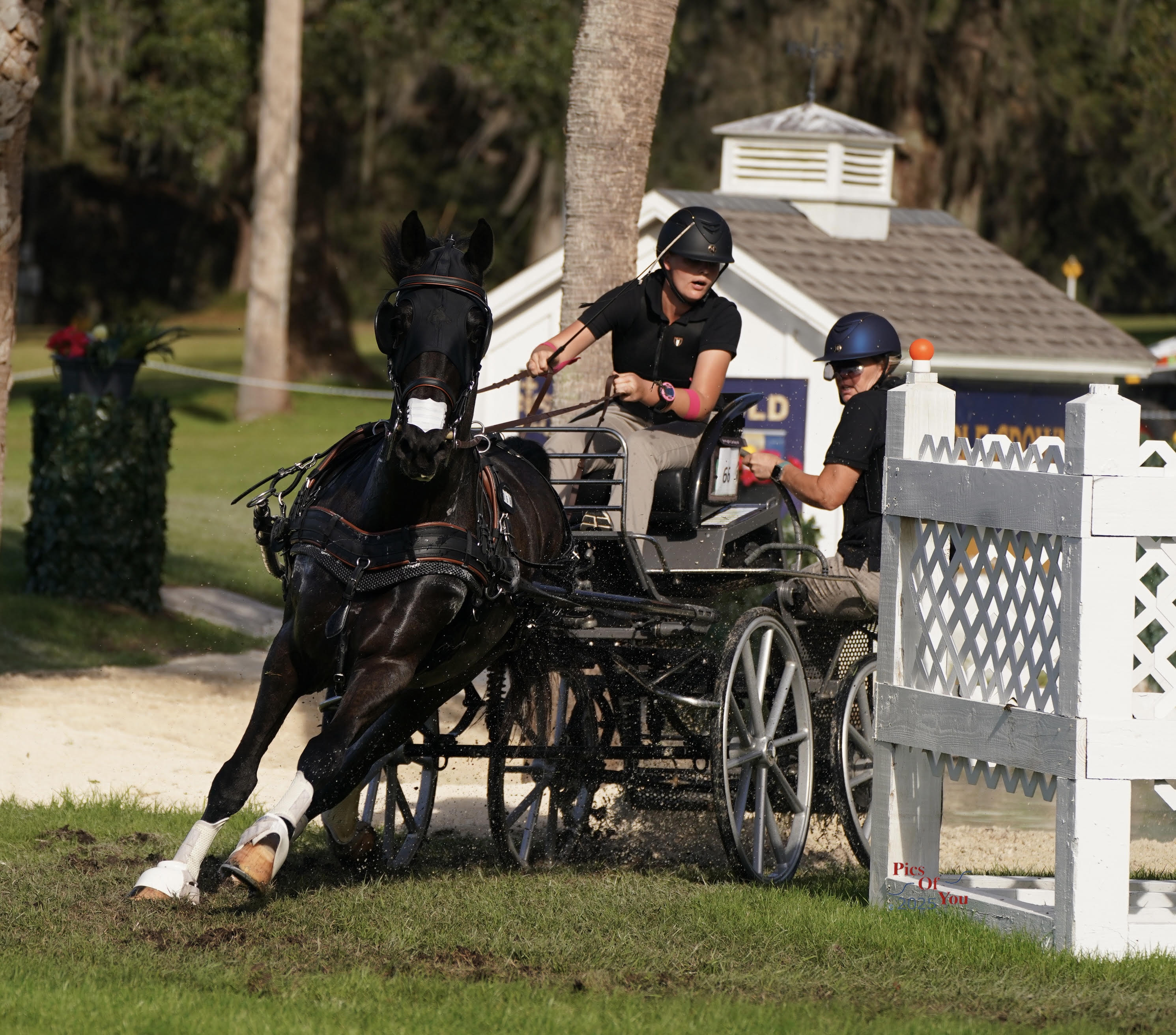Horse Leg Injuries Prevention: What You Need to Know
Posted by FLAIR Strips on Feb 17th 2025

Ryley Miller Team and Java at Grand Oaks CDE, photo courtesy of picsofyou.
Nothing sidelines a horse faster than a leg injury. Whether you're training for competition or enjoying long rides, keeping their legs healthy is essential. Horse leg injuries prevention starts with smart training, proper conditioning, and the right care routine. Ignoring these factors can lead to strains, sprains, and long-term damage that affects performance and well-being.
By understanding what causes leg injuries and taking proactive steps, you can reduce risks and help your horse stay sound. In this guide, we’ll explore common injury triggers, effective prevention strategies, and how to create a training program that supports equine leg health.
Understanding Common Causes of Leg Injuries
Horse leg injuries prevention starts with understanding the common causes of these injuries. Improper training techniques often lead to unnecessary strain on a horse's legs. For example, pushing a horse too hard without proper warm-up can cause muscle and joint stress. Over-exertion is another significant factor, as it can lead to fatigue and increase the risk of injury.
Inadequate warm-up routines are a common oversight in horse training. A proper warm-up prepares the horse's muscles and joints for the physical demands of training. Without it, the risk of injury increases significantly. It's essential to incorporate stretching and light exercises before engaging in more intense activities.
Another crucial aspect of horse leg injuries prevention is ensuring the right gear is used. Proper saddle fit is vital to avoid unnecessary pressure on the horse's back and legs. Addressing saddle fit issues can significantly reduce the risk of injury. By understanding these common causes, trainers can take proactive steps to protect their horses.
Importance of Proper Training Techniques
Proper training techniques are essential for horse training safety. Structured routines help mitigate the risk of injury by gradually increasing intensity and ensuring adequate rest periods. This approach allows horses to build strength and endurance without overloading their bodies.
Gradual intensity increase is crucial in preventing injuries. Sudden spikes in training intensity can lead to muscle strain and fatigue. By slowly increasing the workload, trainers can help their horses adapt and strengthen over time. Rest periods are equally important, allowing the horse's body to recover and repair.
Strengthening equine muscles is another key aspect of injury prevention. Activating the thoracic sling muscles, for instance, can provide better support and stability during training. Insights on strengthening these muscles can contribute to a safer training environment. Supporting a horse’s respiratory health is also vital for overall performance and endurance. FLAIR™ Strips help reduce airway resistance, making breathing easier and aiding in faster recovery after intense exercise.By focusing on proper techniques, trainers can enhance horse training safety and reduce the risk of leg injuries.
The Role of Nutrition in Leg Health
Nutrition plays a vital role in equine leg health. A well-balanced diet provides the necessary nutrients to strengthen bones and muscles, reducing the likelihood of injuries. Essential nutrients like calcium and phosphorus are crucial for bone health, while proteins support muscle development.
Incorporating a variety of nutrients into a horse's diet can significantly impact their overall health. Vitamins and minerals contribute to strong bones and resilient muscles, essential for maintaining leg health. A diet rich in these elements supports the horse's physical demands during training.
Understanding the correlation between diet and leg health is crucial for horse owners and trainers. Comprehensive horse health tips can guide you in providing the best nutrition for your equine companion. Explore more about maintaining horse health through proper nutrition. By prioritizing a balanced diet, you can enhance equine leg health and prevent injuries.
Important Facts About Preventing Injuries in a Horse's Lower Legs During TrainingMaintaining leg health in horses is vital for their safety and performance. Horse leg injuries are common and can lead to serious consequences. These injuries can affect a horse's ability to train and compete. By understanding the causes and prevention strategies, horse owners can better protect their horses. Here are some important facts to consider:
|
Recognizing Early Signs of Stress
Understanding the early signs of stress in a horse's legs is crucial for effective horse leg injuries prevention. Regular checks and a keen eye for changes in behavior or movement can make a significant difference. Horses may exhibit subtle signs such as reluctance to move, changes in gait, or even slight swelling. By recognizing these indicators early, owners can address potential issues before they escalate into serious injuries. Observing your horse's behavior is essential; for instance, if a horse starts misbehaving or showing unusual resistance, it might be a sign of discomfort or pain.
Another critical aspect of recognizing stress is monitoring the horse's legs for physical changes. Regularly feeling the legs for heat or swelling can help detect problems early. It's also beneficial to note any changes in the horse's performance, as these can be early indicators of stress. Consistent monitoring and early intervention are key components of equine leg health, ensuring that minor issues do not develop into major injuries.
Incorporating these practices into your routine not only aids in early detection but also enhances horse training safety. By being proactive and attentive, you can maintain your horse's well-being and prevent unnecessary stress on their legs.
Incorporating Rest and Recovery
Incorporating rest and recovery into a horse's training schedule is vital for maintaining equine leg health. Rest days allow the horse's muscles and joints to recover, reducing the risk of overuse injuries. Active recovery sessions, such as light walking or swimming, can promote circulation and aid in muscle repair without adding undue stress. These strategies are essential for horse training safety, ensuring that the horse remains in peak condition.
Balancing intense training with adequate rest is crucial. Overworking a horse can lead to fatigue, which increases the likelihood of injuries. Implementing rest days and varying the intensity of workouts can help manage fatigue and keep the horse healthy. For more methods on managing fatigue effectively, consider exploring this guide.
By prioritizing rest and recovery, owners can enhance their horse's performance and longevity. This approach not only prevents injuries but also supports overall equine leg health. Ensuring that your horse has time to recuperate is a fundamental aspect of a safe and effective training program.
Equipment and Environment
The right equipment and environment play a significant role in horse leg injuries prevention. Factors such as terrain, shoes, and training surfaces can greatly influence the risk of injury. Ensuring that the horse is trained on suitable surfaces and wears appropriate shoes can mitigate the impact on their legs. These considerations are crucial for maintaining equine leg health and preventing unnecessary strain.
Training surfaces should be even and free from hazards that could cause trips or falls. The choice of shoes should also be tailored to the horse's specific needs, providing adequate support and protection. By paying attention to these details, owners can enhance horse training safety and reduce the risk of leg injuries.
Creating a safe training environment is not just about preventing injuries; it's about fostering a space where horses can thrive. By optimizing both equipment and environment, owners can support their horse's health and performance.
FAQs: Horse Leg Injuries Prevention
The FAQ section provides answers to common questions about horse leg injuries. These answers help you take proactive steps to ensure equine leg health.
What are the immediate steps to take if my horse shows signs of a leg injury?
If you notice signs of injury, you should first allow your horse to rest. Inspect the leg for swelling or heat. Using cold therapy, such as ice packs, can reduce swelling. Contacting a vet for a thorough examination is always a good precaution.
How often should I inspect my horse's legs for potential issues?
Inspect your horse's legs daily. This helps you catch early signs of stress. Regular checks lead to timely interventions that prevent serious injuries.
Are there specific exercises that can help strengthen a horse's legs?
Certain exercises build leg strength. Ground poles and hill work are helpful. These routines improve balance and muscle tone. Controlled trotting is another method that supports equine leg health.
How can I tell if my horse's training intensity is too high?
Watch for signs like fatigue, reluctance to work, or changes in gait. These can indicate overtraining. If you see these signs, consider reducing the intensity or frequency of training sessions.
What are the best recovery practices after intense training sessions?
After intense sessions, ensure your horse has rest days. Incorporate active recovery methods like light walking or swimming.
Core Insights on Equine Leg Health
Horse leg injuries happen often during training. This makes prevention crucial. Start by understanding what causes these injuries. Improper training, skipping warm-ups, and doing too much too soon can all lead to problems. Structured routines help reduce risk. Training should be gradual, with enough rest. Nutrition also plays a big role. Balanced diets strengthen bones and muscles. This lowers injury chances.
Being alert to early signs of stress is key. Watch for changes in behavior or movement. Regular checks can catch issues before they get worse. Rest and recovery are also vital. Horses need rest days and recovery activities like walking or swimming. Proper equipment and training environments prevent many injuries. This includes using the right shoes and surfaces.
Addressing common questions helps manage horse safety and health. Knowing what to do if a horse shows injury signs is important. Regular leg checks and knowing when training is too intense can save a lot of trouble. Exercises that build strength are helpful too.
All these elements work together to keep horses healthy and safe. They create a safe training space where horses can perform well. Monitoring equine health and implementing safety measures are essential. They ensure your horse is in the best shape and ready to train.
Conclusion: Safeguard Your Horse's Future
Keeping your horse in peak condition requires a proactive approach to training, care, and recovery. From proper nutrition and rest to high-quality equipment, every detail matters. One often-overlooked aspect of performance and well-being is respiratory health—a crucial factor in reducing fatigue, improving endurance, and supporting recovery.
Prioritize your horse's well-being now. For more expert tips, explore more here. Of course, your horse's legs aren't the only thing that need protecting. FLAIR® Equine Nasal Strips help by reducing airway resistance, making breathing easier for your horse. By supporting their nasal passages, FLAIR Strips minimize stress on the lungs, helping to prevent conditions like Exercise-Induced Pulmonary Hemorrhage (EIPH). Check out the many options we have in our store today. Whether your horse is racing, jumping, or training hard, optimizing their breathing can enhance performance and long-term health.





